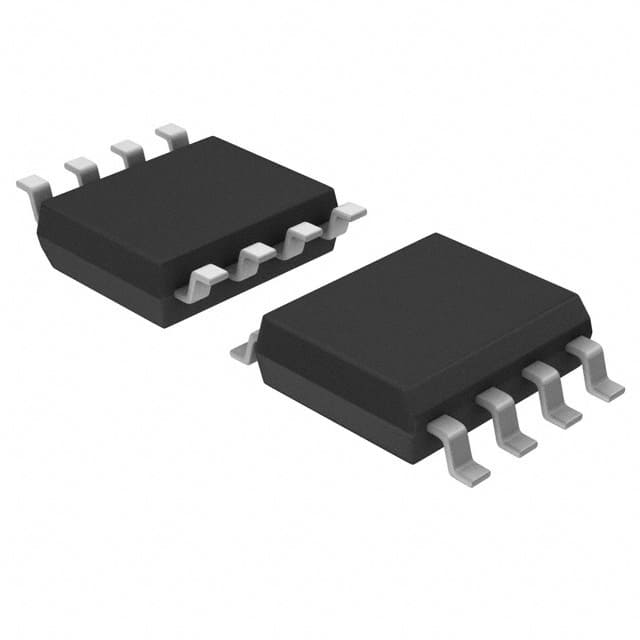X9C503ST2
Product Overview
Category: Electronic Component
Use: Digital Potentiometer
Characteristics: Programmable, Non-volatile, 50kΩ Resistance Range
Package: SOT-23
Essence: Integrated Circuit (IC)
Packaging/Quantity: Tape and Reel, 3000 units per reel
Specifications
- Resistance Range: 50kΩ
- Number of Taps: 100
- Supply Voltage: 2.7V to 5.5V
- Temperature Range: -40°C to +85°C
- End-to-End Resistance Tolerance: ±20%
- Increment/Decrement Step Size: 1 LSB (Least Significant Bit)
- Non-volatile Memory: Stores wiper position during power-off
- Low Power Consumption: <1μA standby current
Detailed Pin Configuration
The X9C503ST2 has a total of 8 pins:
- VCC: Supply voltage input
- H: High terminal of the resistor array
- W: Wiper terminal of the resistor array
- L: Low terminal of the resistor array
- CS: Chip select input
- U/D: Up/Down control input
- INC: Increment control input
- GND: Ground reference
Functional Features
- Digitally programmable potentiometer
- Allows adjustment of resistance through digital control signals
- Non-volatile memory retains wiper position even when power is off
- Increment and decrement control for precise adjustments
- Wide operating voltage range for versatile applications
- Low power consumption ensures energy efficiency
Advantages and Disadvantages
Advantages: - Easy to integrate into electronic circuits - Precise resistance adjustment with fine resolution - Non-volatile memory eliminates the need for external storage - Low power consumption prolongs battery life - Compact SOT-23 package saves board space
Disadvantages: - Limited resistance range (50kΩ) - End-to-end resistance tolerance of ±20% may affect accuracy in some applications
Working Principles
The X9C503ST2 is a digital potentiometer that replaces traditional mechanical potentiometers. It consists of a resistor array and a wiper terminal controlled by digital signals. The resistance value between the wiper terminal and either end terminal can be adjusted digitally, allowing precise control over the output voltage or current.
The non-volatile memory feature ensures that the wiper position is retained even when the power is turned off. This eliminates the need for external storage devices to store the desired resistance setting.
Detailed Application Field Plans
The X9C503ST2 finds applications in various fields, including:
- Audio Equipment: Volume control, tone adjustment
- Industrial Control Systems: Calibration, fine-tuning
- Test and Measurement Instruments: Signal conditioning, calibration
- Consumer Electronics: Brightness control, contrast adjustment
- Automotive Electronics: Climate control, motor speed control
Detailed and Complete Alternative Models
- X9C103S: 10kΩ resistance range, 100 taps
- X9C203S: 20kΩ resistance range, 100 taps
- X9C303S: 30kΩ resistance range, 100 taps
- X9C403S: 40kΩ resistance range, 100 taps
- X9C603S: 60kΩ resistance range, 100 taps
These alternative models offer different resistance ranges while maintaining similar functionality to the X9C503ST2.
Word count: 431 words
قم بإدراج 10 أسئلة وإجابات شائعة تتعلق بتطبيق X9C503ST2 في الحلول التقنية
Sure! Here are 10 common questions and answers related to the application of X9C503ST2 in technical solutions:
Q: What is the X9C503ST2? A: The X9C503ST2 is a digitally controlled potentiometer, commonly used for electronic volume control or as a variable resistor in various technical applications.
Q: How does the X9C503ST2 work? A: The X9C503ST2 uses digital signals to control the resistance value. It consists of a series of resistive elements and switches that can be toggled on or off to adjust the overall resistance.
Q: What is the voltage range supported by the X9C503ST2? A: The X9C503ST2 typically supports a voltage range of 0V to 5V, making it suitable for use in low-voltage applications.
Q: Can the X9C503ST2 be used in both analog and digital circuits? A: Yes, the X9C503ST2 can be used in both analog and digital circuits, depending on the specific application requirements.
Q: How precise is the X9C503ST2 in terms of resistance adjustment? A: The X9C503ST2 offers good precision with typical resistance step sizes of around 100 ohms, allowing for fine-grained adjustments.
Q: Is the X9C503ST2 compatible with microcontrollers or other digital control systems? A: Yes, the X9C503ST2 can be easily interfaced with microcontrollers or other digital control systems using standard communication protocols such as I2C or SPI.
Q: Can the X9C503ST2 handle high currents? A: No, the X9C503ST2 is designed for low-current applications. If high currents are involved, it is recommended to use external buffering or amplification.
Q: What is the typical lifespan of the X9C503ST2? A: The X9C503ST2 has a typical lifespan of several thousand cycles, but this can vary depending on the specific operating conditions and usage patterns.
Q: Can the X9C503ST2 be used in automotive applications? A: Yes, the X9C503ST2 is suitable for automotive applications as long as the voltage and current requirements are within its specified limits.
Q: Are there any specific precautions to consider when using the X9C503ST2? A: It is important to avoid exceeding the maximum voltage and current ratings of the X9C503ST2. Additionally, proper ESD protection measures should be taken during handling and installation to prevent damage to the device.
Please note that these answers are general and may vary depending on the specific datasheet and manufacturer guidelines for the X9C503ST2.


